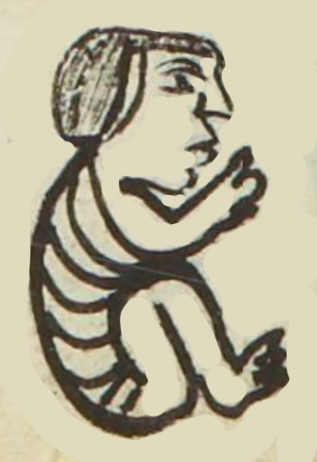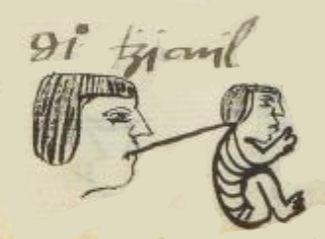Tzicuil (MH835r)
This black-line drawing of the simplex glyph for the personal name Tzicuil (perhaps “Thin Bodied," or Cicuil, "Ribs," attested here as a man’s name) shows a profile view of a small, naked human in a fetal position but sitting facing the viewer’s right. His knees and elbows are bent, and his back is rounded. His arms are slightly forward. The most prominent feature on this body is the ribs (cicuilli or omicicuilli). Perhaps he is someone who has become very thin (suggesting the verb tzicuilihui).
Stephanie Wood
Terms for ribs and becoming thin can start with ci- or tzi- apparently. Regardless of the spelling, a semantic and homophonic relationship between these words seems clear. It is also worth noting that there was a revered Tzicuiltzin that perhaps this person was named after. She was a daughter (and the first child) of Quinatzin. She was also the mother of don Francisco Carlos Xoconochtzin. (See: History and Mythology of the Aztecs: The Codex Chimalpopoca, 1998, 50.)
Stephanie Wood
dio. tzicuil
Diego Tzicuil
Stephanie Wood
1560
Jeff Haskett-Wood
flaco, delgado, costillas, nombres de hombres

Tzicuiltzin, a famous name, https://nahuatl.wired-humanities.org/content/tzicuiltzin
tzicuilihui, to become thin, https://nahuatl.wired-humanities.org/content/tzicuilihui
cicuil(li), small body or carcass, https://nahuatl.wired-humanities.org/content/cicuilli
omicicuil(li), rib bones, https://nahuatl.wired-humanities.org/content/omicicuilli
Delgado
Stephanie Wood
Matrícula de Huexotzinco, folio 835r, World Digital Library, https://www.loc.gov/resource/gdcwdl.wdl_15282/?sp=744&st=image.
This manuscript is hosted by the Library of Congress and the World Digital Library; used here with the Creative Commons, “Attribution-NonCommercial-ShareAlike 3.0 License” (CC-BY-NC-SAq 3.0).




